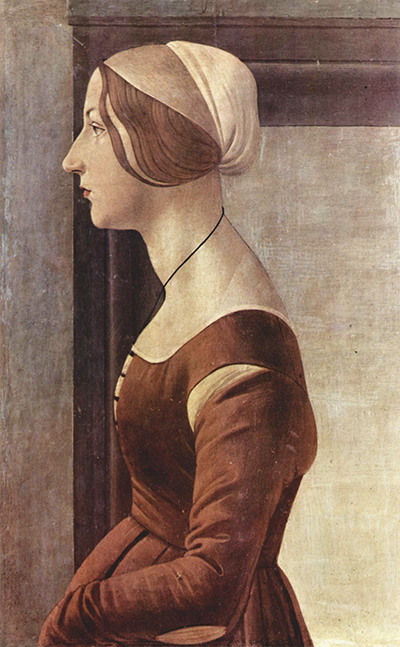This Portrait of a Young Woman can be found at the Palazzo Pitti in Florence. The painting is dated at around 1475 but we can only give an approximate date, as is the case for many of Sandro Botticelli's artworks.
The artist used tempera whether he was working on small panels, as in the case of this portrait, or when he applied his designs directly onto the walls of buildings. This was entirely typical of the Italian Renaissance, as most artists worked in this way throughout the various stages of that movement. Tempera was derived from eggs and all of the Italian masters of that era would work with it, including Da Vinci and Michelangelo. Raphael however preferred to use oils in most of his paintings and this underlined how tastes within Italy were starting to change towards the end of the Renaissance era. Botticelli himself was very much a star of its earlier stages, known by most simply as the Early Renaissance. It would be Netherlandish artists who encouraged the use of oils within Italy but it took centuries before it replaced tempera as the dominant medium.
The portrait in front of us here features a slim, tall woman in side profile. The composition captures her from around waist-up. She is wearing a brown outfit with hair covering and appears to be some sort of maid for a local Florentine family. Botticelli manages to re-create ripples on the material, such as on her right arm. Her clothing is hard wearing and smart, without being overly glamorous. Behind her the artist adds a touch of architecture which might have been the corner of a room. The young woman holds a fairly neutral expression, somewhat serious, and this is how the artist normally requested his sitters to pose, in line with Renaissance traditions. He liked to capture the lives of local Florentines as a means to practicing his skills of portraiture but as his career took off he would start to deliver more ambitious, large-scale projects which would become the biggest highlights of his career.
Having been relatively forgotten for several centuries, Botticelli has been re-appraised in recent years and is now considered amongst the most talented and influential of contributors to the Early Renaissance. His highlights would include breaktaking pieces such as Pallas and the Centaur, Madonna of the Magnificat and The Mystical Nativity which are not really served well by digital imagery and are much better enjoyed in person. His paintings have made it over to the US and other parts of Europe but much remains in his native Italy, partly because some of them are really not suitable for moving elsewhere, such is their fragility. Florence continues to be one of the best cities from where to enjoy this artist's work as a good number have remained in the artist's hometown.




